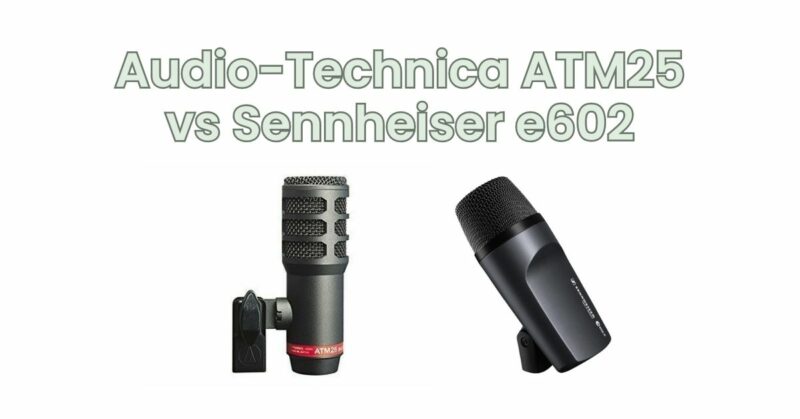Choosing the right microphone for capturing the deep and impactful sound of a kick drum is crucial in achieving a powerful and well-defined low-end in your recordings. The Audio-Technica ATM25 and the Sennheiser e602 are two popular dynamic microphones specifically designed for kick drum applications. In this article, we will compare the Audio-Technica ATM25 and the Sennheiser e602, exploring their features, sound characteristics, and suitability for capturing the low-frequency energy of kick drums.
- Audio-Technica ATM25:
- Sennheiser e602:
Audio-Technica ATM25 Overview: The Audio-Technica ATM25 is a dynamic microphone renowned for its ability to handle high sound pressure levels and deliver accurate low-frequency reproduction. It features a hypercardioid polar pattern, offering excellent off-axis rejection and focused sound capture. The ATM25 has a robust construction, designed to withstand the demands of live performances and studio applications.
Sennheiser e602 Overview: The Sennheiser e602 is a dedicated kick drum microphone known for its deep and punchy sound reproduction. It features a cardioid polar pattern, providing good isolation of the kick drum sound source and minimizing bleed from other instruments. The e602 has a rugged build quality, making it suitable for both stage and studio use.
Sound Characteristics: The Audio-Technica ATM25 excels in capturing the low-end frequencies of kick drums with clarity and definition. It offers a balanced frequency response, emphasizing the punch and impact of the drum while maintaining accuracy. The ATM25’s extended low-frequency response ensures a solid and tight low-end reproduction, making it suitable for various musical genres.
The Sennheiser e602 delivers a rich and pronounced low-frequency response, emphasizing the weight and depth of the kick drum sound. It offers excellent transient response, capturing the attack and sustain of the drum with precision. The e602 provides a well-rounded and full-bodied kick drum sound, making it a popular choice for professional drum recording.
Build Quality and Design: The Audio-Technica ATM25 is built to withstand the rigors of live performances, featuring a durable metal construction and a shock-mounted capsule to minimize handling noise. It includes a built-in stand mount, allowing for easy placement and positioning.
The Sennheiser e602 boasts a robust and roadworthy design, with a reinforced metal body and a shock-mounted capsule to eliminate handling noise and vibrations. It includes an integrated stand mount, providing stability and flexibility in positioning.
Applications and Versatility: Both microphones are primarily designed for kick drum applications but can also be used for other low-frequency instruments such as bass amplifiers and floor toms. The Audio-Technica ATM25’s balanced sound and high SPL handling make it suitable for various music styles and live sound reinforcement. The Sennheiser e602’s pronounced low-frequency response and excellent transient response make it well-suited for capturing the punch and weight of kick drums in both live and studio settings.
Price and Value: The Audio-Technica ATM25 is generally priced lower than the Sennheiser e602, offering excellent value for its performance and affordability. It provides a solid option for those seeking a reliable kick drum microphone on a budget. The Sennheiser e602, while at a higher price point, delivers a specific and sought-after kick drum sound that justifies its cost for professional applications.
The Audio-Technica ATM25 and the Sennheiser e602 are both reliable choices for capturing the powerful sound of kick drums. The ATM25 offers a balanced and accurate representation of the kick drum, suitable for a wide range of musical genres. The e602 emphasizes the low-frequency impact and delivers a rich and pronounced kick drum sound. Consider your specific recording needs, budget, and desired sound characteristics to determine which microphone best suits your requirements.


